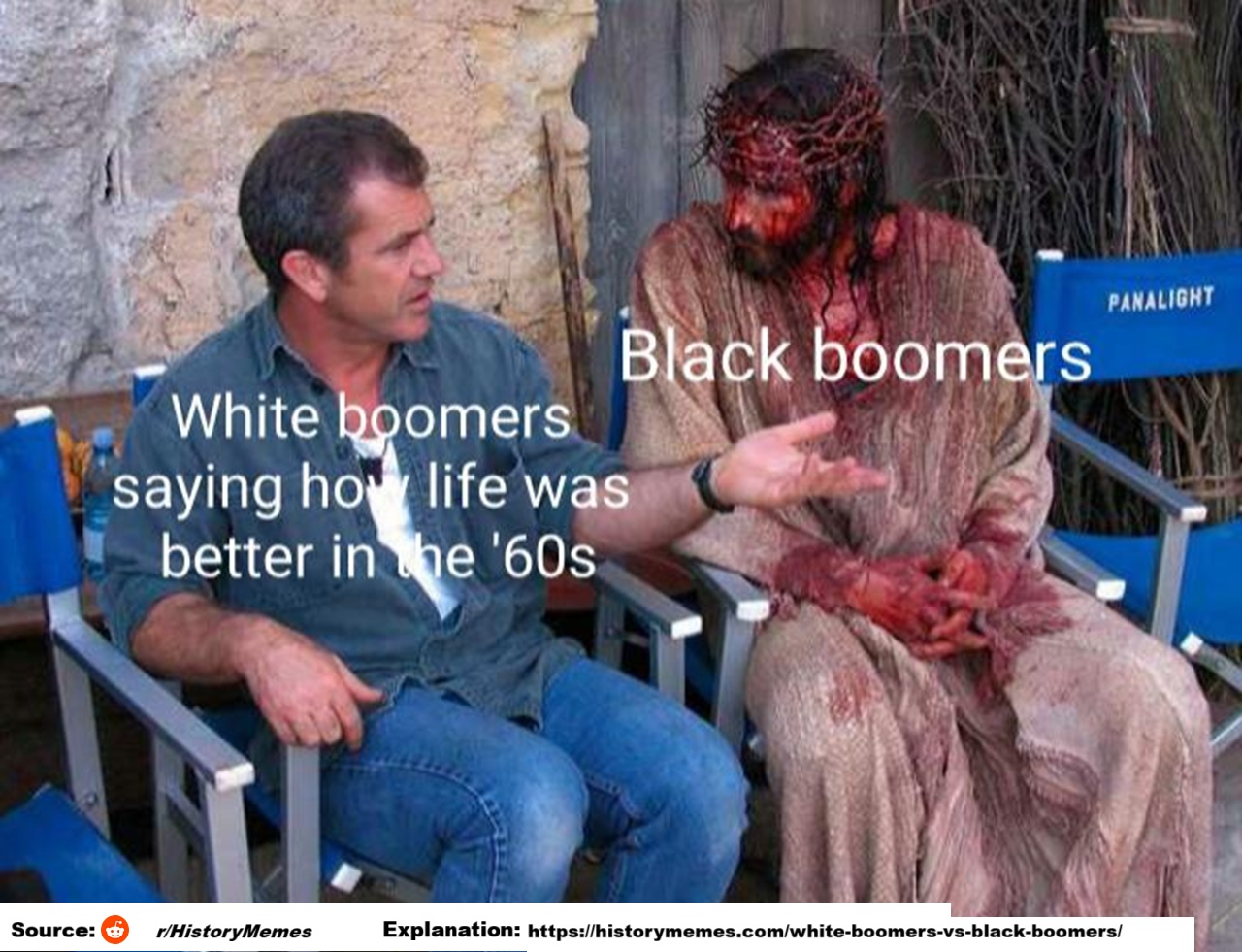
- Over Mel Gibson: “White boomers saying how life was better in the ’60s.”
- Over the bloody Jesus actor: “Black boomers.”
The joke / Meaning
The meme is contrasting different perspectives on the 1960s in the U.S. depending on race:
- White boomers (baby boomers born roughly 1946–1964) often nostalgically recall the 1960s as a “simpler” or “better” time (good economy, cultural milestones, suburban expansion, etc.).
- Black boomers, however, had a very different lived reality in the 1960s, experiencing segregation, systemic racism, police violence, and fighting for civil rights.
The bloody Jesus (Black boomers) symbolizes the suffering and hardship endured, while Mel Gibson calmly chatting (White boomers) symbolizes the casual nostalgia disconnected from that suffering.
Why many white boomers see the 1960s as “better”
For many white Americans, especially those in the middle class, the post-WWII decades (1950s–60s) were a time of prosperity and relative stability:
- Economic opportunity: The U.S. had a booming manufacturing economy, strong unions, and affordable housing. Wages were good, and many families could thrive on a single income.
- GI Bill & education: Programs like the GI Bill (though unevenly applied racially) made it easier for white veterans to buy homes and go to college.
- Suburban expansion: The rise of suburbs offered many white families safe, affordable neighborhoods, new schools, and car-centered lifestyles.
- Cultural nostalgia: Rock ’n’ roll, Woodstock, the moon landing, and the sense of being part of a rapidly modernizing society are remembered fondly.
- Relative privilege: White boomers, especially in segregated or mostly white communities, were largely insulated from racial discrimination, systemic poverty, and police violence.
So, for many white baby boomers, the ’60s felt like a golden age, even if it wasn’t universally so.
Why many Black boomers had a very different experience
For African Americans, the 1960s were marked by systemic racism, violence, and the fight for civil rights. Some key struggles:
- Segregation: Jim Crow laws in the South legally enforced separate schools, restaurants, buses, and even water fountains. Black boomers grew up being denied equal access to education and public spaces.
- Housing discrimination: Redlining and exclusion from many suburban developments (like Levittown) meant Black families were denied homeownership opportunities that white families took for granted.
- Economic inequality: Black workers were often excluded from better-paying union jobs or faced workplace discrimination.
- Violence & intimidation: Peaceful protests were met with police brutality, fire hoses, dogs, and sometimes murder (e.g., Birmingham, Selma, Mississippi Freedom Summer).
- Civil rights struggle: While the Civil Rights Act (1964) and Voting Rights Act (1965) were major victories, these rights were hard-fought and resisted by many in white society.
- Daily racism: Beyond laws, everyday life included insults, harassment, and lack of protection from authorities.
Moreover, it’s not just that Black boomers had it harder, it’s that white nostalgia often erases or ignores Black suffering.
Some more books on the subject:
Leave a Reply